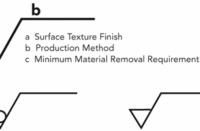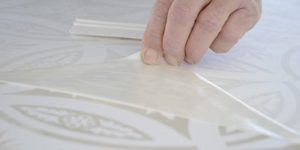Often, before writing an article or blog post, I go back and research questions I have answered in previous months, looking for inspiration and ideas. It always amazes me how I can go back and clearly chart which products were popular and what the hot trend of the day was based on the type and number of questions I received on a certain subject. Fast forward to present-day decorative concrete America, and once again a trend can be seen. Today’s trend has less to do with any certain product and more to do with a weak economy and saving money. Just like people are finding ways to make their cars go another year to save money, so too are they are looking for ways to make their existing concrete work another year. The number of questions dealing with low cost and easy ways to turn a gray slab into something decorative has increased significantly over the last few months.
Along with the increase in “how” and “what to do” comes the increase in “how come” and “what if.” This article is not about the products and systems filling the rapidly growing “low cost, make it look pretty” void, but the common misconceptions, pitfalls and problems that accompany this decorative trend.
The three decorative product families making up today’s popular trend are stains (I include acid, water-based and acrylic stains and dyes in this category), decorative overlays and sealers. These are all products that are post-applied (after curing) to concrete. They don’t require forms, ready-mixed concrete or lots of labor. Let’s take a look at each separately in terms of the common problems and mishaps.
The all-encompassing “stains” category still elicits the most questions and problems compared to other decorative product categories, hands down.
The most common misconception is that stains will cover past sins or cracks and worn areas on old or existing concrete. For those of you who make a living from staining concrete, you know this is far from the truth, and in fact most stains highlight or enhance what I like to refer to as “character marks” in concrete. Installer beware – manage your customers’ expectations from the start, and take the extra time to explain in as much detail as necessary that staining concrete will alter the color of the slab (to a point), but will not hide structural or profile issues, such as cracks, pop-outs, worn areas and major color differences.
Now, keep in mind that there are translucent stains and opaque stains. Each will provide a different level of “hide,” ranging from soft tints all the way to 100 percent coverage, similar to paint. I have found that wood and how it takes stain is a good comparison when trying to explain options and results to those outside the industry. It seems most everyone can relate to how a stain affects wood, so using this to explain how concrete will look after a certain type of stain is applied always seems to get the light bulb to go on.
The other common staining misconception is that any concrete in any condition, in any environment, can accept stain, and the results are guaranteed to look like the pretty pictures on the back of the color selection chart or on the Concrete Decor Web site. Most stains are penetrating and will enhance the surface they are applied to. However, the saying “garbage in, garbage out” really holds true. Stains are only as good as the quality of the surface they are applied to.
If the surface is not prepared properly, you will not achieve good results. I have seen a dramatic rise in the number of people suffering from stain failures where attempts were made to cover carpet glue, tile mastic, or other types of contamination present on the concrete. The perception that old carpet or linoleum can be ripped out and stain applied without any additional preparation is an almost certain recipe for stain failure, or at a minimum, a less than satisfactory result. Even in a tough economy, where projects are hard to come by and competition for the same job is fierce, don’t lose sight of the limitations these products carry and the true costs associated with installing them. I encourage anyone looking for that low-cost or “easy” stain fix to slow down and consider the true costs and steps involved with proper installation.
The typical progression for those asking for advice or assistance with a stain problem leads to decorative overlays. “We ripped the carpet out from our main floor and basement and applied a stain,” is the typical lead-in question. “The stain looks terrible, the stain color and sealer is coming up all over the floor, and I can see all the marks where the carpet glue and adhesive used to be – what can I put over this to fix it?”
This inevitably leads to a discussion about decorative overlays, specifically microtopping systems. I am actually a big fan of decorative overlays, and I have personally applied tens of thousands of square feet successfully, quite a bit of it in my own home. If applied properly, and more importantly, maintained properly, they will last for years and years. Therein lies the issue. As with stain, decorative overlays seem to emit this sense of false security and lure of easy money. The common problem with overlays is not the product – the mixing and application is the easy part. It is surface preparation prior to installation. I find that almost all DIYers and a fair number of professional installers don’t really understand surface preparation and how to achieve a surface profile that will provide the adhesion these overlays require for a successful installation.
The end result is often the same. Months later, the overlay is failing, and I can tell you from experience, repairing an overlay that usually has stain or some form of aesthetic coloring is time-consuming, expensive and almost never meets the standards of a now very wary homeowner or client. If you are considering a decorative overlay, please understand that there are no shortcuts or new revolutionary products that eliminate the surface preparation stages. Too often I am asked to consult or provide solutions for overlay failures where all parties involved tried to save time and money by eliminating all or some of the preparation steps.
Overlay products are great solutions for floors that have glue or mastic residue, construction contamination, or are just old and worn. They provide a new pallete on which to stain, color or texture. However, understand the product and process. Choose the product that is best suited for your application, and plan on spending more time and money on surface preparation than on the actual overlay.
After looking at the stain and at overlays, we come to sealing. Of the three products we are discussing, the most significant increase in the number of questions and problems in the last 6 months comes from the sealer category.
While sealers, both clear and colored, are a cost-effective way to make concrete of all types look better, they are not foolproof. Consider that most tinted or colored sealers provide a translucent effect. They do not hide or cover up those “character marks” we talked about earlier. Inexperienced applicators are not aware of this, so when the first coat does not provide the desired color or effect, common sense says apply another coat, and double up the amount just to make sure. This is a one-way ticket to sealer failure. Most decorative sealers are designed to go down thin. Building thick coats to achieve that solid color or shiny “wet look” leads to sealer diffusion. This is when the sealer comes away from the substrate or previous sealer coat, creating the classic white/gray hazy look you get when sealers fail.
The other big issues with using sealers as low-cost decorative finishes all deal with application. I don’t have time in this piece to go into detail, but a dry surface between 50 F and 90 F, free from any and all contamination, is critical to any new or reseal application. Also, take the time to read the installation guidelines for the particular sealer being applied. Not all sealers are applied the same way.
After writing a piece about problems, I always take a deep breath and consider that with the millions of square feet of successful installations that go down every year, the percentage that are problem jobs is actually very small. As with past economic downturns, this one will pass. As we start to see the light at the end of the tunnel, I will again be looking forward to identifying the next trend in the always-changing world of decorative concrete.
















